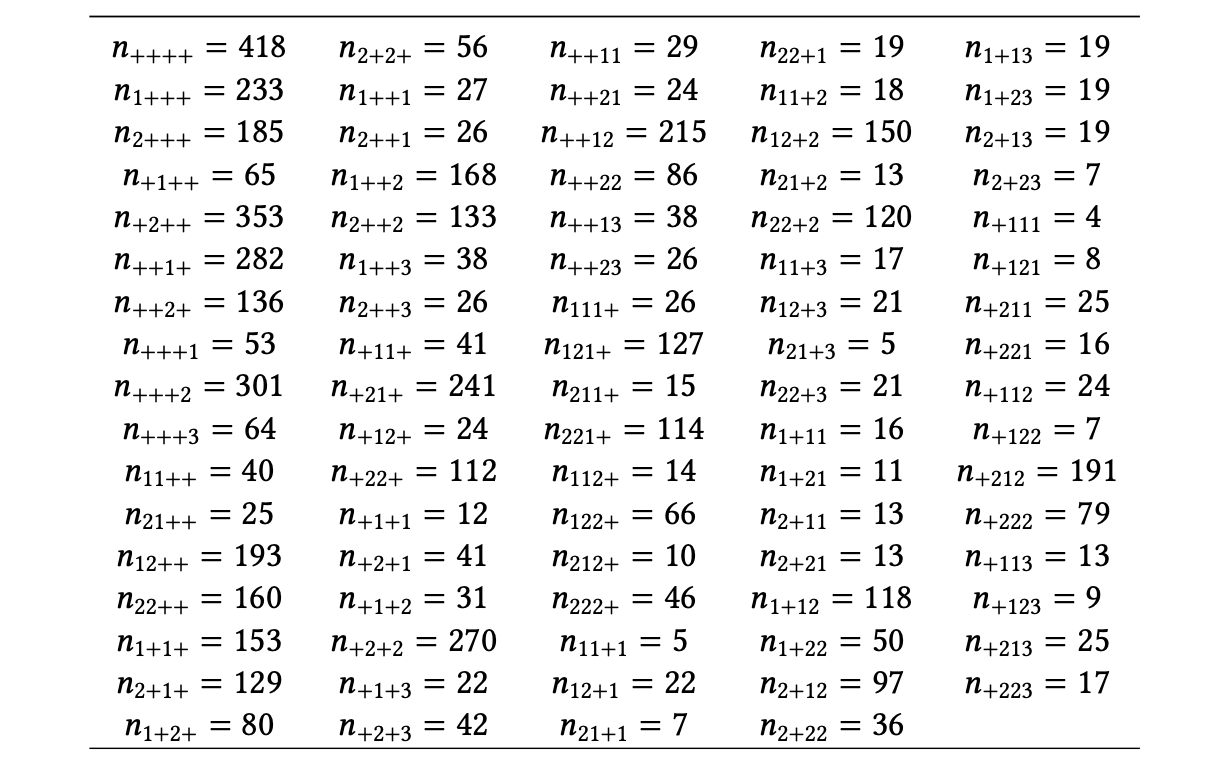Multidimensional Log-Linear Modeling (Case Study: Gender, Age, Head Circumference, and Nutritional Status Among Early Childhood Children)
Main Article Content
Abstract
Poor nutritional status tends to increase the risk of morbidity and mortality among children in developing countries. Therefore, data on these rates can be an important indicator in describing the condition of undernutrition in a community. Log-linear model analysis can be used to categorize data on nutritional status. Based on data obtained from the Rajabasa Indah Health Center area, Rajabasa Subdistrict, Bandar Lampung City, there are 418 children who have examined at the Posyandu. The analysis model conducted in this study involves four variables, each variable is categorized into several categories according to predetermined criteria. Gender with two categories (male and female), age with two categories (1-12 months and 13-60 months), head circumference with two categories (normal and abnormal), and nutritional status with three categories (undernourished, well-nourished, and overnourished). This study aims to determine the best model using log-linear analysis that can explain the relationship between the four variables. The results obtained are the best model for the data involved in the [UG][LG][J] structure, the structure describes the interaction between age and nutritional status and head circumference and nutritional status.
Article Details
References
[1] Windi Lestari, Bernadhita Herindri Samodera Utami, Mustofa Usman, Vitri Aprilla Handayani, et al. Robust panel data regression analysis using the least trimmed squares (lts) estimator on poverty line data in lampung province. Integra: Journal of Integrated Mathematics and Computer Science, 1(2):35–42, 2024.
[2] Marco Riani, Anthony C Atkinson, Gianluca Morelli, and Aldo Corbellini. The use of modern robust regression analysis with graphics: an example from marketing. Stats, 8(1), 2025.
[3] Mohd Faris Dziauddin and Zulkefli Idris. Use of geographically weighted regression (gwr) method to estimate the effects of location attributes on the residential property values. The Indonesian Journal of Geography, 49(1):97, 2017.
[4] Syarli Dita Anjani, Bernadhita Herindri Samodera Utami, Mustofa Usman, Vitri Aprilla Handayani, et al. Geographically weighted ridge regression modelling on 2023 poverty indicators data in the provinces of west kalimantan and central kalimantan. Integra: Journal of Integrated Mathematics and Computer Science, 1(3):73–80, 2024.
[5] Alan Agresti. Categorical Data Analysis Third Edition. John Wiley & Sons, 2013.
[6] Jaka Nugraha. Pengantar analisis data kategorik: Metode dan aplikasi menggunakan program R. Deepublish, 2014.
[7] Ronald Christensen. Log-linear models and logistic regression. Springer, 1997.
[8] J. Zhao and L. Wang. Application of multidimensional log-linear models in social science data analysis. Journal of Statistical Research, 55(2):123–138, 2021.
[9] Jeffrey M. Wooldridge. Introductory Econometrics: A Modern Approach. South-Western Cengage Learning, 2016.
[10] Carolyn J. Anderson, Maria Kateri, and Irini Moustaki. Log-linear and log-multiplicative association models for categorical data. In Trends and Challenges in Categorical Data Analysis: Statistical Modelling and Interpretation, pages 1–42. Springer, 2023.
[11] Sarah Lee. Essential insights into log-linear models for data analysis. Journal of Multivariate Analysis, 58(3):145–162, 2025.
[12] Miftahul Janah and Alif Yuanita Kartini. Penerapan metode regresi linier berganda pada kasus balita gizi buruk di kabupaten Bojonegoro. STATKOM: Jurnal Statistika dan Komputasi, 1(2):74–82, 2022.
[13] Wahyuni Maria Prasetyo Hutomo, Irfandi Rahman, Irma Idris, and Astriani Ohoiner. Hubungan antara jenis kelamin dengan status gizi pada bayi usia tiga tahun. Nursing Arts, 18(1):28–35, 2024.
[14] Riyadhul Fajri, M. Kom, S. Iqbal, S. Sriwinar, Fitri Rizani, S. Kom, Heri Gustami, Win Konadi, and Yusrizal Akmal. Statistika Deskriptif & Probabilitas. Madza, 2024.
[15] Rini Rahani and Elma Theana. Pembentukan model log linier tiga dimensi pada asosiasi sikap diskriminatif dan stigma terhadap orang dengan HIV/AIDS, pengetahuan komprehensif HIV/AIDS dan tingkat pendidikan remaja perempuan di Indonesia. Jurnal Statistika dan Aplikasinya, 6(2):300–312, 2022.
[16] Tan Ade Indra Satria, Nurfitri Imro’ah, and Nur’ainul Miftahul Huda. Penerapan model log linier dalam menganalisis tabel kontingensi dua arah. BIMASTER: Buletin Ilmiah Matematika, Statistika dan Terapannya, 12(6):545–552, 2023.
[17] Indah Suciati, Warsono Warsono, and Mustofa Usman. Analysis of linear log models on COVID-19 data in Indonesia. Sciencestatistics: Journal of Statistics, Probability, and Its Application, 1(1):1–7, 2023.
[18] Jihyeok Im, Donghyeon Woo, and Dongsoo Kong. Log-linear model and delivery load analysis for improvements in water quality through TMDL in the Gyeongan stream watershed, Republic of Korea. Sustainability, 16(11):4456, 2024.
[19] Ledys Cuesta-Herrera, H.A. Torres-Mantilla, Militza Quintero-Vega, Rafael Borges-Peña, and N. Martínez-Jeraldo. Log-linear modeling between risk factors and interactions for human papillomaviruses infection and Papanicolaou smear abnormalities. In Journal of Physics: Conference Series, volume 2516, page 012008. IOP Publishing, 2023.
[20] Vera Maya Santi, Fanya Izmi Hawa, and Bagus Sumargo. Log linier binomial negatif dalam memodelkan data siswa putus sekolah tingkat SMA/SMK. Jurnal Statistika dan Aplikasinya, 7(2):207–214, 2023.
[21] Supariasa, I Dewa Nyoman, Bachyar Bakri, and Ibnu Fajar. Penilaian Status Gizi. Jakarta: EGC, 2020.
[22] Abdu Hailu Shibeshi and Zeytu Gashaw Asfaw. The influence of minimum dietary diversity on undernutrition among children aged 6–23 months in Ethiopia: a multilevel mixed-effect analysis based on 2019 Ethiopian mini demographic and health survey. Frontiers in Public Health, 12:1436683, 2024.
[23] Kementerian Kesehatan RI. Peraturan Menteri Kesehatan RI Nomor 2 Tahun 2020 tentang Standar Antropometri Anak. Jakarta: Kementerian Kesehatan RI, 2020.
[24] Kementerian Kesehatan RI. Hasil survei status gizi Indonesia (SSGI). Technical Report, Kementerian Kesehatan RI, 2022.

